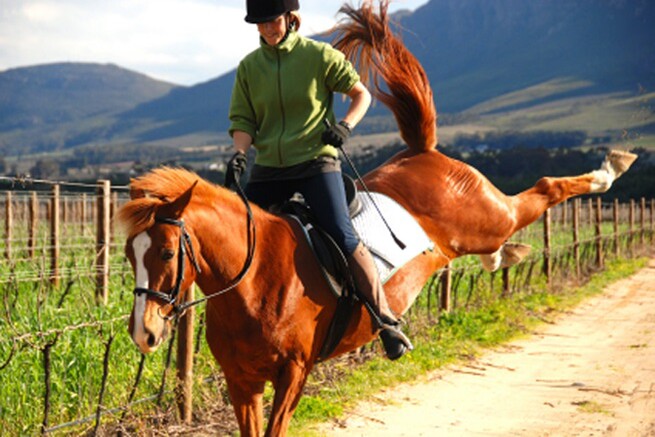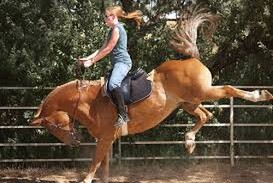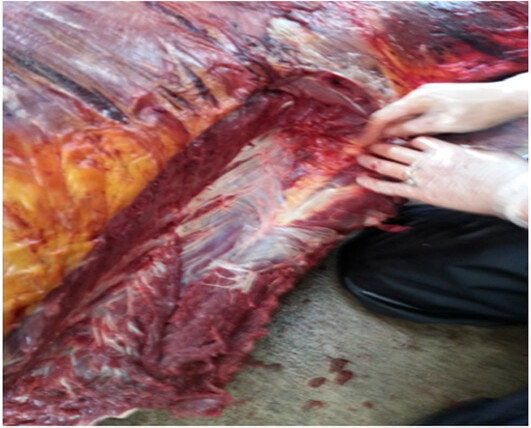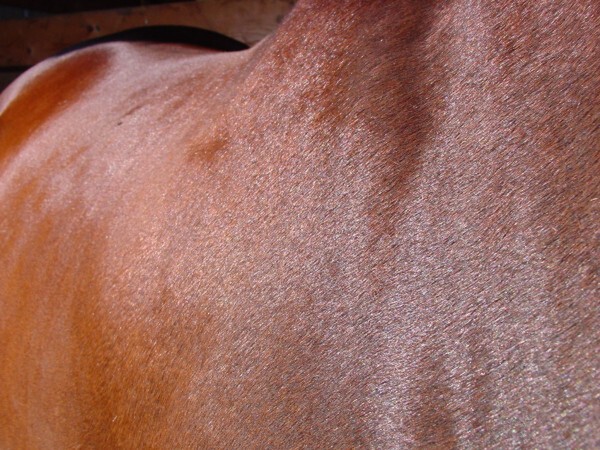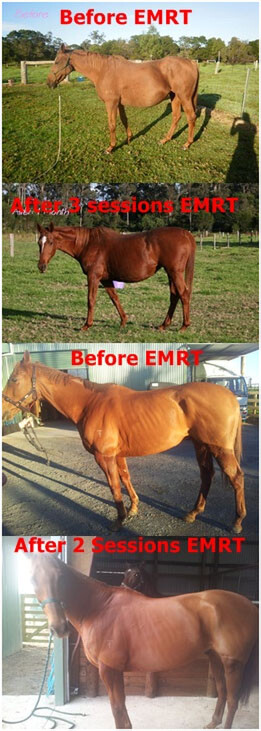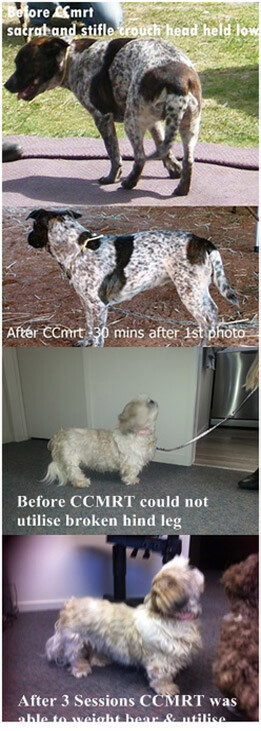What happens in the horse’s body when being ridden, how the rider’s imbalance, muscular imbalance and scar tissue in the horse can restrict the horse’s movements and create pain.Often misbehavior due to pain is interpreted as naughtiness. There goes the dream for the rider…. It is not much fun if the horse doesn't even want to be caught in the paddock, if it holds the head high and swishes the tail, gallops off, bucks or bites when ridden.
Often horses express pain or misbehave in a way that scare or upset their riders. Besides problems created by bad saddle fitting, unsuitable bit or hoof problems horse also may suffer from pain created by a suppressed, triggered or pinched nerve, movement blockages or even tooth ache. Horses can’t speak to us and often their way to communicate is met by us with a lack of understanding.When performing a Bowen / Acupuncture session on a horse or dog, you may sometimes hear me saying the fascia is restricted, tight or dehydrated over a certain region. Sometimes it is has to be explained what I mean by this, thus, I thought a blog would be beneficial in explaining what Fascia is and how it appears to affect the body as a whole.
There is now extensive research in humans being done on the importance of fascia, a very good article to read on Fascia has been written by Dr Warren Hammer.The knowledge that normal muscle function depends on the fascial system and between 30 and 40 percent of the force generated by muscle is due to its surrounding fascia.Science has dismissed the value of a connective tissue structure that encompasses our whole body both internally and externally.Research demonstrates that more than 30 percent of the force generated from the muscle is transmitted not along a tendon, but rather by the connective tissue within the muscle and fascia contains mechanoreceptors and proprioceptors. In other words, every time we use a muscle, we stretch fascia that is connected to spindle cells. The normal stretching of fascia thus communicates the force of the muscle contraction and the status of the muscle regarding its tone, movement, rate of change in muscle length and position of the associated body part to the central nervous system (CNS)Fascia – All animals and humans included - are born with a connective tissue covering or suit which covers us from head to toe and encases all organs, muscles, nerves and etc. Which we usually think of as our skin. The fascia “suit” is the connective tissue that extends throughout our body, not only lying just beneath the skin but also surrounding and connecting every organ, muscle, bone, nerve and blood vessel, and more. Fascia is a continuous web that surrounds and separates, supports and protects down to the cellular level, while allows the body to move freely.As explained by certain vets such as Ridgeway, Fascia is likened to a spider web, If you touch one part of the web, the whole fabricated net moves (just like a tensegrity model), providing instantaneous information for the spider to act or react. Fascia acts in the same manner. It is a whole body communication system where, if stimulated, transmits a signal to every part of the body.Fascia shape-shifts into tough, flexible supporting structures like ligaments and tendons, and forms the ‘bursae’ that reduce friction and allow free movement over joints. One of its most important jobs is to produce scar tissue after an injury, to stabilize the area while it’s being repaired. Another vital job is to keep the muscles separate so that they can slide past each other as they work in different directions. In a dissection of an animal you can remove different layers of muscle due to the packaging/ covering of the fascia over each group. Muscles are covered by specific types of deep fascia, designated as either epimysial or aponeurotic fascia. In the extremities, a thin layer of epimysial fascia called the epimysium envelops the surface of each muscle. It surrounds the entire surface of the muscle belly and separates it from adjoining muscles. It gives form to all of the extremity muscles. Aponeurotic Fascia AF helps transmit the force of the muscles it covers and is innervated mostly in its superficial layer.While fascia is supporting the body, it also helps with delivery of fluids, nutrients and oxygen as well as removal of toxins and waste. Electrical impulses flow through it and it is thought that the energy or life force known as “chi” in Chinese medicine flows through it as well. This is where EMRT (bowen)/ acupuncture comes into play.When Fascia Is ChallengedWhen fascia is injured, an inflammatory response changes it from a squishy gel to a stiff solid and affects electrical conductivity, muscleWhich horse/dog has healthy fascia?All of this congestion impacts the animal’s ability to move and to learn. Stiffened fascia leads to poor posture and biomechanics, with lowered strength and endurance. With an impeded or painful nervous system, it can lead to dull, reactive or unpredictable behavior.Like any other part of the body, maintenance and repair of fascia is affected by poor or unbalanced nutrition.Chronic pain or stress also impacts the fascia. Constant tension in the muscles reduces circulation, causing the fascia to become stiff and dry.Fascia is often damaged by trauma: blows, strains, tears, or lacerations. As a natural part of healing, scar tissue forms at the site of damage, then disappears during the repair process. Often, however, poor circulation, lack of movement, and/ or incomplete nutrition don’t allow the healing process to be completed, leaving behind adhesions (stuck-together tissues) and stiffness.Chronic overwork or repeated injuries also affect fascia. If a horse is trained into an artificial way of standing or moving, or worked beyond his ability to recover completely, or kept in a constant state of tension, the fascia is stressed along with overused muscles, tendons and ligaments.When we notice that our animals “fascia” is too tight, when the skin doesn’t slipover the body, and movement is stiff and short, what can we do?Generally “What the body can do, it can undo.” The body has a built-in memory of its proper shape and healthy movement or function, and how it feels to live free of pain and restriction. It has a built-in mechanism to return to health.This is especially true for fascia. It is able to change from a solid back to a gel, responding to pressure by warming and moving.
Triggering with acupuncture and Bowen Therapy can free up fascia, through a technique called “myofascial release”. As we work with the fascia, tension eases, which lowers resistance to flow, reduces pressure on pain-sensitive tissues (nerves and blood vessels), and restores proper mechanical length and alignment to the muscles. Joints are set free to move, and the horse’s flexibility, coordination, and strength improve.Myofascial release is also a simple way to improve trust and communication. It is valuable for troubled or abused horses, as it can help the horse learn to associate the release with pain relief, and relaxation. Often after one or two sessions owners always express how quiet and happy the horse/dog has become and much easier to handle. Sometimes if the animal has had chronic pain and always very stoic may appear much more active and out of it’s shell depending on the issue.How to Address Problem Areas
- Fascia just under the skin allows the whole body room to live in, and improves circulation to the skin so it can perform its many functions. As life goes on, this superficial fascia might shrink, pucker, or tear, becoming tight or twisted.
- To begin, scan for areas where the skin does not move over the body. You might find these on the upper shoulders or neck, the back, and over the upper rib cage or the croup.
- The middle layer of fascia holds the organs, vessels, nerves, bones, and muscles in place; it organizes the body, forms compartments, and surrounds every layer of muscle fibers. When it is tight, it prevents full muscle contraction and relaxation, and lowers circulation and nerve conductance, leading to compromised tissues and organs all overthe body. To clear fascial restrictions in the middle layers, a more focused pressure is used with acupuncture or specific Bowen moves to affect deeper tissues
- Scar tissue can disappear over time as you bring circulation in and help the body heal the area.
- Gentle movement and stretching are important to restore a healthy flow of movement and good posture. You can unwind fascia by moving a part of the body, or helping the animal move, into a release position.
- Normal muscle function requires that it’s surrounding fascia to be hydrated so as to allow normal tissue gliding.
- Improper tissue gliding is directly related to mechanoreceptive and proprioceptive failure and muscle incoordination.
- Dysfunction occurs over myofascial kinetic chains, which is related to both the myofascial and acupuncture meridian fascial planes.
- A full case history should be considered in areas of previous trauma or surgery which could reveal fascial thicknesses responsible for present complaints.
- Practical testing and palpation of fascial planes are a major diagnostic method.
- Treatment of affected points should be continued until normal thickness is palpated and negative testing improves.

